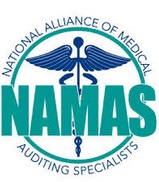by NAMAS
Jul 5th, 2019
Over the past few months, I have worked with different organizations that have been misinterpreting the "incident to" guidelines and, in return, have been billing for services rendered by staff that are not qualified to perform the services per AMA and CPT. What I found within the variances is that they were following the guidance of "incident to", but not identifying that CPT still has a separate set of guidelines specific to the CPT codes being billed that have to be paired with CMS guidance.
Often times when an audit is returned with variances, I am asked to provide a specific guideline/policy in black and white that spells out the steps of how I am applying a concept to E/M coding. Whenever I am auditing/educating I base my methods and information on specific CMS and/or other payer policies and, as auditors, we all know that there are the gray or unspoken areas of a policy that we are left to walk our providers, coders and auditors through.
While I did not previously think "incident to" was very subjective, I found myself wondering how the different groups came to their conclusion and I had to go back to the basics to figure out their mind set and to help further explain the appropriate use. "Incident to" services are defined as those services that are furnished incident to physician professional services or services supervised by certain non-physician practitioners such as physician assistants, nurse practitioners, clinical nurse specialists, nurse midwives or clinical psychologists, which are subject to the same requirement as physician-supervised services.
The findings that surprised me the most was the use of "incident to" and the billing of physician or other qualified health care provider (QHP) services for staff that had a master's degree or doctorate, but were not credentialed and not licensed practitioners. Some of the cases reviewed showed performance of psychotherapy services by the non-licensed staff that was billed under a psychologist. Other cases reviewed showed developmental testing with interpretation and report being performed by non-licensed and non-credentialed staff and billed under a physician. At first glance the documentation did support the service, but then looking more closely I realized that the CPT codes were for services that per AMA and CPT guidelines are to be rendered by a physician or QHP.
You may be asking what the problem is if the note fully supported the service and "incident to" documentation requirements were met. The answer to that is, the use of "incident to" policies do not cancel out the CPT requirements for services rendered. I know for myself I get so wrapped up in the world of CMS that I often forget that there is basic language within CPT that some people may be misinterpreting or not following once they are applying a CMS guideline.
Per AMA the definition of a Qualified Healthcare Professional - "A 'physician or other qualified health care professional' is an individual who is qualified by education, training, licensure/regulation (when applicable) and facility privileging (when applicable) who performs a professional service within his/her scope of practice and independently reports that professional service." Clinical staff (medical assistants, licensed practical nurses, registered nurses) are different from QHP's as they work under the supervision of a physician or other QHP to perform or assist in services as allowed by law, regulation, and facility policy; but who do not individually report that professional service.
When a non-licensed and non-credentialed employee is rendering services and you are looking to bill for them "incident to" a physician or QHP, the CPT code description and explanations (can be found in CPT Assistants and coding software programs) need to be carefully reviewed. It is important to determine whether the staff member is allowed to perform as a billable service and if CPT states "physician or other QHP" that employee cannot render the service and bill for it under a supervising practitioner.
About NAMAS
NAMAS is setting the standards in medical auditing & education
The NAMAS team and faculty work hard to bring you membership resources, products, tools, and training that is not only timely and specific to medical auditing and compliance, but also that is specific to the needs of medical practices today. NAMAS staff are industry recognized experts who provide audits and consulting services to active clients which gives NAMAS the cutting edge to provide relevant training.

Helping Others Understand How to Apply Incident to Guidelines. (2019, July 5). Find-A-Code Articles. Retrieved from https://www.findacode.com/articles/helping-others-understand-how-to-apply-incident-to-guidelines-35008.html
© 2019 InnoviHealth Systems Inc


 Quick, Current, Complete - www.findacode.com
Quick, Current, Complete - www.findacode.com